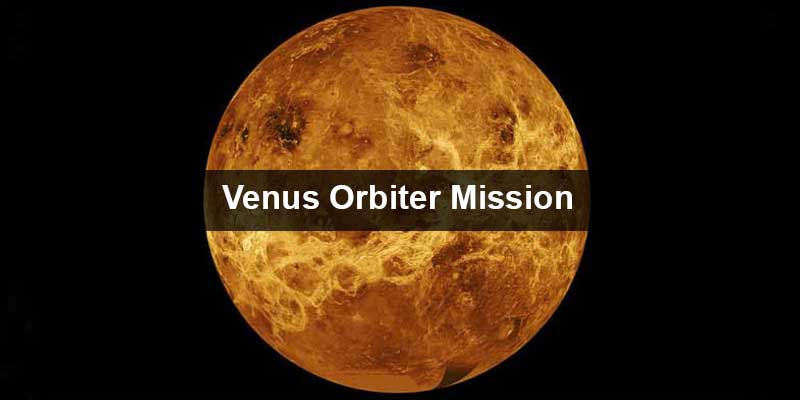- India
- Oct 03
- Kevin Savio Antony
ISRO targets to launch Venus Orbiter Mission in March 2028
• India’s Venus Orbiter Mission is planned to be launched in March 2028 and will embark on a 112-day journey to reach the planet.
• The Rs 1,236-crore Venus Orbiter Mission (VOM) was recently approved by the Union Cabinet and the Indian Space Research Organisation (ISRO) revealed the targeted launch window for the mission.
• The VOM by ISRO is scheduled for launch on March 29, 2028, with an expected arrival at Venus on July 19, 2028.
• This mission will be launched using the Launch Vehicle Mark-3 (LVM-3), ISRO’s heavy-lift launch vehicle.
• The spacecraft will be placed in an Elliptical Parking Orbit (EPO) of 170 km x 36,000 km, with an inclination of 21.5 degrees and an Argument of Perigee (AOP) of 178 degrees.
• The Venus Orbiter Mission will study the surface topography of the planet, Venusian dust and clouds, lightning, volcanic activity, atmosphere, ionosphere, solar forcing and the Sun-Venus interaction.
• It will also study the underlying causes of the transformation of Venus, which is believed to be once habitable and quite similar to Earth.
• It is expected to answer some of the outstanding scientific questions resulting in various scientific outcomes.
• The mission will be accomplished by the Department of Space.
Key Phases and Details:
• Launch and Elliptical Parking Orbit (EPO): The spacecraft will be launched into an EPO, where it will orbit Earth before heading towards Venus.
• Venus Orbit Injection (VOI): After the cruise phase, the spacecraft will be injected into an elliptical orbit around Venus of 500 km x 60,000 km.
• Aerobraking Maneuver: Over a period of six to eight months, aerobraking will be used to gradually lower the spacecraft into the desired Science Orbit of 200 km x 600 km with a 90-degree inclination. This will allow for low-altitude science operations and studies of Venus’s atmosphere and surface.
Scientific Objectives:
• Study the dust in Venus’s atmosphere.
• High-resolution mapping of Venus’s surface topography.
• Investigate the solar X-ray spectrum near Venus.
• Analyse Venusian airglow.
• Examine sub-surface characteristics of the planet.
• Explore the interaction between Venus and the Sun.
Payloads:
A total of 19 payloads onboard VOM, including 16 Indian payloads, two collaborative payloads (Indian and international), and one international payload.
Quick facts on Venus:
• Venus is the second planet from the Sun and is Earth’s closest planetary neighbour.
• Venus is often called Earth’s twin because it’s similar in size and density. However – there are radical differences between the two worlds.
• Venus has a thick, toxic atmosphere filled with carbon dioxide and it’s perpetually shrouded in thick, yellowish clouds of sulfuric acid that trap heat, causing a runaway greenhouse effect.
• It is the hottest planet in our solar system, even though Mercury is closer to the Sun. Surface temperatures on Venus are about 900 degrees Fahrenheit (475 degrees Celsius) – hot enough to melt lead.
• The surface is a rusty colour and it is peppered with intensely crunched mountains and thousands of large volcanoes.
• Venus has crushing air pressure at its surface – more than 90 times that of Earth.
• Venus rotates on its axis backward, compared to most of the other planets in the solar system. This means that, on Venus, the Sun rises in the west and sets in the east.
• Venus rotates very slowly on its axis – one day on Venus lasts 243 Earth days. The planet orbits the Sun faster than Earth, however, so one year on Venus takes only about 225 Earth days, making a Venusian day longer than its year.
Past missions to Venus
• Venus was the first planet to be explored by a spacecraft – NASA’s Mariner 2 successfully flew by and scanned the cloud-covered world on December 14, 1962.
• Since then, numerous spacecrafts from the US and other space agencies have explored Venus, including NASA’s Magellan, which mapped the planet’s surface with radar.
• Soviet spacecraft made the most successful landings on the surface of Venus to date, but they didn’t survive long due to the extreme heat and crushing pressure.
• More recent Venus missions include ESA’s Venus Express (which orbited from 2006 until 2016) and Japan’s Akatsuki Venus Climate Orbiter (orbiting since 2016).
• NASA’s Parker Solar Probe has made multiple flybys of Venus.
(The author is a trainer for Civil Services aspirants.)

